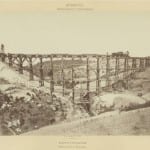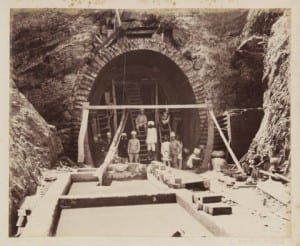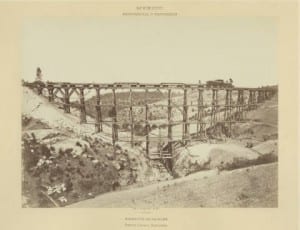I. “Bengal-Nagpur Railway Construction, Photograph No. 09.” Townshend Photography (1890). http://digitalcollections.smu.edu/cdm/singleitem/collection/eaa/id/1473/rec/10
When first glancing at the Indian railway construction photograph, one would think the workers were of similar class or social standing. However, looking closer, the group is separated between native Indian workers and British engineers, or supervisors. In the photo, there lies many tools and supplies of railroad construction, intricate-looking tunnels, and the Indian workers wearing their native headgear—turbans. The only activity going on seems to be a break in the action from building, as they all look relaxed together. Based on the photograph, one can deduce that the Indians and British do not look tense around each other. Rather, they seem at ease and not in conflict like they had been thirty years prior. The Indians also look to be shedding their ‘effeminate’ title, looking strong and confident in the photo. Lastly, the project itself looks well organized and thought out, a compliment to both parties involved. Two questions remain after analyzing this important photograph. First, what is this railway’s general purpose for India? And, finally, who benefits the most from this innovation—the British or Indians?
II. “Viaducto de Jajalpa.” Abel Briquet (1885-1895). http://digitalcollections.smu.edu/cdm/singleitem/collection/mex/id/525/rec/12
This still photograph of a locomotive crossing a ‘viaducto’ in Mexico contains no people, but it contains a deeper meaning nonetheless. In the photo, one clearly sees the steam locomotive and the intricate bride it crosses over. The only action perceived to take place here is the train carrying supplies somewhere important, either for the native Mexicans or for some other purpose. One notable observation that can be made from this photo comes from the idea that this furthers the Mexican industrial progress, making it comparable to India’s industrial revolution. Secondly, one can assume that the locomotive itself was a huge relief in its’ ability to quickly and largely deliver goods from one rural town to another throughout Mexico. The architecture of the ‘viaducto’ is also very impressive, prompting one to both compliment and question the creator of such a project at the time. To conclude, a viewer might ask who did build the bridge—natives or outside influences; as well as asking what the train is actually carrying and for whom.



